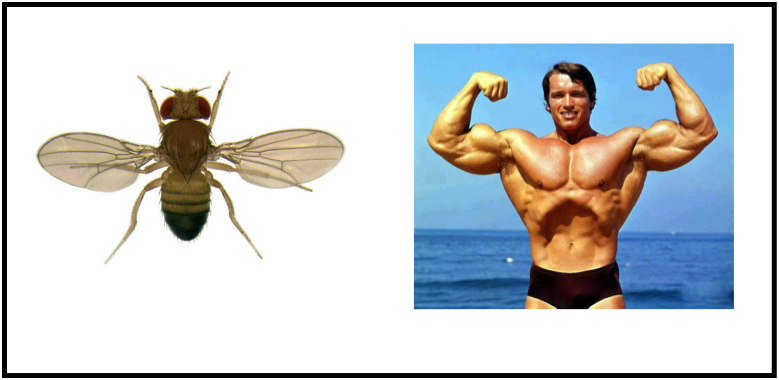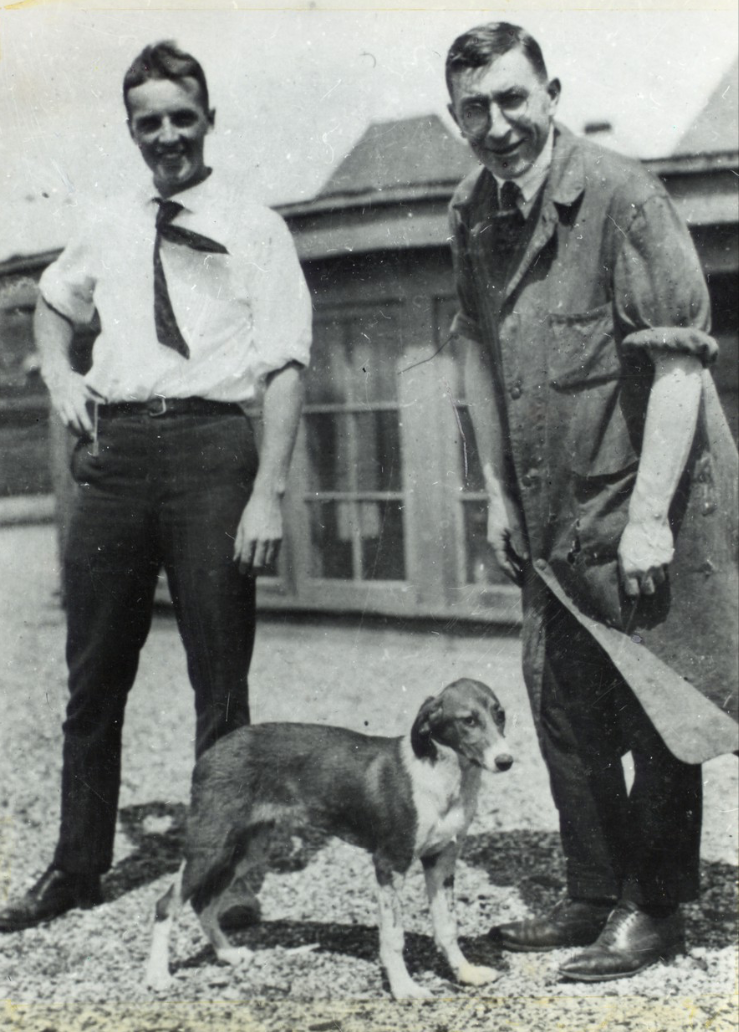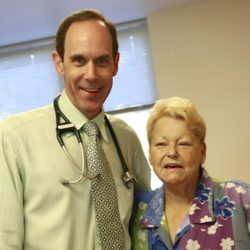Charles Best and Frederick Banting, with one of their research subjects. University of Toronto Archives
This post describes some of the many pathways to scientific discovery. No single model applies to all discoveries, and most discoveries contain elements of different models. I will focus on the field I know best, biomedical research. Biomedical discoveries are usually, but not exclusively, the result of hypothesis- and curiosity-driven “small science”. In contrast, the first report of evidence for the Higgs Boson at the LHC in Switzerland listed over 2500 authors from some 180 institutions, and depended on the construction of a 5 billion dollar supercollider with an annual operating budget of one billion. That’s really big science.
The intentional discovery of insulin
Some discoveries in biology or medicine are made by scientists who set out to solve a particular problem, or to describe a particular phenomenon. An example from years past is the isolation of insulin by Frederick Banting and colleagues at the University of Toronto.
Banting was a surgeon, but his medical practice in the small city of London, Ontario wasn’t particularly successful. There weren’t enough patients coming through the door, so in his spare time he started lecturing to medical students at the University of Western Ontario. Also, he was interested in diabetes, and wanted to make a contribution to its treatment. He studied the available literature intensely. He knew that scientists in Europe had shown that secretions from the pancreas prevented diabetes, and helped regulate sugar metabolism. To pursue his interest in diabetes, Banting applied for a research position at the University of Toronto, and in 1921 he left London for Toronto and a date with destiny.
Banting’s approach was based on the earlier work he had read about. He induced diabetes in dogs by tying off the duct that delivered secretions from the pancreas to the bloodstream. Earlier workers had named the secretion whose absence led to diabetes “insulin”, because cells of the tissue called the Islands of Langerhans in the pancreas produced it. But they had been unable to reverse diabetes by injecting extracts of the pancreas. Whatever the material was, it didn’t survive attempts to isolate it. The crucial contribution that Banting and his colleagues made was to isolate the active diabetes-suppressing protein, insulin.
Banting was assigned the young medical student Charles Best as a helper for the summer. (Best later became a noted physiologist, and a co-author of a standard Physiology textbook.) In late 1921 the group was joined by a visiting biochemist, James Collip from the University of Alberta. And by January of the next year, Banting and colleagues announced that they could isolate active insulin. It reduced the blood sugar, and urinary sugar production, in dogs made diabetic by tying off the pancreas. The problem had apparently been that, in addition to insulin, the pancreas produces proteases essential for digesting protein in the diet. Insulin is a protein, and it was being degraded by the proteases in pancreatic secretions. The Toronto team developed a process for isolating insulin from slaughterhouse animals on a large scale. Miraculously, the animal material worked in diabetic humans; it was used to treat a 14-year-old boy named Leonard Thompson, who was dying of diabetes, and it saved his life.
The story happened with breathtaking speed. Banting arrived in Toronto in May, 1921. The group reported a positive result with diabetic dogs in December, 1921, and Leonard Thompson was saved from diabetes in late January of 1922. In 1923, Banting and his mentor, Professor J. J. R. Macleod, were awarded the Nobel Prize in Physiology or Medicine. Banting was 32, and remains the youngest person to ever win that Prize. (There is an enormous amount of interesting context in that turbulent story, and it is told in entertaining style by Michael Bliss in “The Discovery of Insulin”.)
Banting and Macleod filed for patent rights on insulin, and then sold those rights to the University of Toronto for one dollar. The university subsequently did very well financially. This was in sharp contrast to the frequent practice today of scientists and institutions with discoveries even of uncertain relevance or value. For example, resveratrol, present in the skins of grapes and in red wine, appeared to increase longevity in model organisms. A biotech startup company was quickly formed to exploit this finding in 2004. This company was purchased by the pharma GlaxoSmithKline for 750 million dollars in 2008. But we are still waiting for the first positive result of beneficial effects of resveratrol on human health or longevity.
The accidental discovery of a treatment for erectile dysfunction
By contrast to the intention-driven story of the discovery of insulin, penicillin is a well-known example of serendipitous observation. Although it was an “accidental” discovery, it only happened because of the acute observations and the trained mind of Alexander Fleming, and the persistent efforts of Ernest Boris Chain and Howard Walter Florey to mass-produce the active material.
A less-well known, and arguably less significant, discovery is related to erectile dysfunction. On the basis of its chemical structure, the drug sildenafil, which had been synthesized in the laboratory of the Pfizer Company, was being tested for its ability to ameliorate heart-related chest pain (angina) in men. It wasn’t much good for that, since it had to be taken at such high doses and for such long times that its side effects became too great. But one side effect was a pleasant surprise: men taking sildenafil began to have unexpected, and unexpectedly strong, erections. In fact, the company had a hard time getting the test subjects to give back the unused pills when the test for angina ended. The company’s ears pricked up, and it began to work toward creating and satisfying an ED market. Today, under the name Viagra, sildenafil is a multi-billion dollar business.
How mass screening led to successful organ transplantation
Perhaps the least inventive method of discovery is mass screening, which is mainly used by pharmaceutical companies. They are the only research agencies with the resources for it. It’s expensive, but it can be effective, as in the case of the drug Cyclosporin A.
As part of its search for new pharmaceutical products, the Sandoz Company in Switzerland asked its scientists to bring back soil samples from their holidays. Since many drugs had been discovered in soil organisms, the logic seemed sound. The company was initially primarily interested in cancer, and would screen samples derived from soil organisms for their ability to attack transplantable tumours in mice or rats, without killing normal cells. Later, a second arm was added: the compounds would also be tested for their ability to interfere with the immune response. This seemed relevant because it was known that tissue rejection was the reason that tissue transplantation, of hearts and kidneys, failed. And the immune system was behind that rejection; perhaps suppressing it could bring transplantation success.
Mice were given an immunological challenge and then injected with test materials. The immune system is complex, and can be impaired or enhanced at any number of points. This is an advantage: You don’t have to know why a test compound interferes with the immune system, just that it does. The mechanism can be worked out later.
Dr. Peter Frey, a Sandoz biologist, returned from a trip to Norway with a soil sample taken from the shore of Lake Skiftesjoen. It contained a fungus whose products were worked up and purified. Then they were tested for their effects on a model immune reaction in mice. After some initial stumbles that could easily have led to its abandonment, a compound was isolated that blocked the cellular immune response, which is the basis for tissue rejection. It didn’t affect either cancer or normal cells, so it was specific. This was a potential candidate for blocking tissue rejection.

It took several years to confirm that it was such a candidate, but then things moved very rapidly. A scientific report in 1976 led to a clinical trial in 1978. The compound was Cyclosporin A (aka cyclosporine), and it became the first drug to enable successful organ transplantation, including kidneys and hearts, in genetically non-identical humans. Other similar compounds have been identified subsequently, and long-term acceptance of allografted organs, as such transplants are called, is now routine.
I have a friend with a kidney transplant, whose immune response to it has been carefully monitored and controlled by such anti-rejection drugs. On January 23 this year he celebrated his well-functioning, adopted kidney’s 18th anniversary.
Modern genetics and biological homology
On October 2, 2017, the Nobel Prize Committee awarded the prize in Physiology or Medicine to three American scientists, Michael Rosbach, Jeffrey Hall, and Michael Young. The three had isolated the genes of circadian rhythm, which causes a 24-hour periodicity in many natural activities. We sleep at night, we are most alert during the day, and we feel out of sorts (“jet lagged”) when we return from a long east-west journey; even some medicines have different effects given at different times of the day. Animals are circadian organisms, as are plants and some bacteria. I have posted previously about circadian rhythm in plants, in humans, and in bacteria.
The three winners had helped uncover a set of genes, at least 10, that regulate circadian rhythm. Perhaps surprisingly, the breakthrough discovery was made in the fruit fly, Drosophila melanogaster. It was, after all, the Prize for Physiology or Medicine. But because of homology, that work had opened the door to the genes of circadian rhythm in humans. By homology, we mean that different organisms often share genes involved in a given process. With the cloned gene from Drosophila melanogaster in hand, you could look for, and find the homolog in mice, and then in humans, and this is what happened.

The human homolog for one of the fly genes, period (italicized because that’s the convention for naming genes), has been identified. Its protein product, PER, is extremely interesting. For example, a human version of period has characteristic mutations in a syndrome called “Familial Advanced Sleep Phase Syndrome” (FASP), in which affected people fall asleep and awaken early. A different period mutation occurs in people suffering from “Seasonal Affective Disorder” (SAD). In flies and mice, period affects a wide variety of biological functions, including the development of cancer, memory, and spontaneous alcohol intake. The story of circadian rhythm in humans is just beginning.
Homology is one of the most powerful tools for discovery in biomedical science, because genes are conserved across species, often even between plants and animals. Because it is much easier to identify and study genes in simple laboratory organisms such as fruit flies, that’s where many important genetic discoveries are made. Another heavily used organism is the inbred mouse (described here).
A scientist named Seymour Benzer identified the period gene in Drosophila in 1971. Benzer was a physicist who had made significant contributions to electronics during World War II. After the war, he joined a university physics department. His enlightened department chief allowed him to explore other research avenues before settling on his post-war direction. Benzer had always been interested in biology, and now he homed in on genetics (training in physics is a good preparation for research in genetics). As a physicist, Benzer was inclined to work with the simplest system he could. He turned to the genetics of bacteriophage, the bacterial viruses, and made important contributions in that field.
Some years later, Benzer was intrigued by behavior, specifically, whether you could identify a genetic component of it. He knew that many genetic studies had been done with the fruit fly, so he started there. He and his student Ron Konopka found that some mutagenized flies (flies with chemically-induced mutations) behaved differently from normal ones. They underwent eclosion, the emergence from the pupal case, at different times than usual. Later, other scientists found that they had a different mating song. (The mating song consists of rapid vibration of the wings of a male fly, creating a “song” that lasts for about a minute, and apparently appeals to lady flies.) This was because of a mutation in a gene Benzer named period. In 1984, the Nobelists of 2007 cloned the period gene of Drosophila, and it was soon evident that that key unlocked mysteries of circadian rhythm in higher organisms, including man.
The story is far more complex than I can describe here. But as a result of finding the homologous human gene, we now know a great deal about an important part of our biology. Genetic identification in simpler organisms, together with homology, is an important part of the art of scientific discovery. And it illustrates, again, the profound unity of biology.
Go to Latest Posts




